
























Welcome to the Summer issue of the White Admiral newsletter. Thank you to all those who have supplied copy for this full issue but it won ’t be long till the next issue is due, so please keep the content coming in. The deadline for the next issue is the 1st October. If you need any more information about writing for the White Admiral please don’t hesitate to get in touch via the details below.
We have some really interesting articles in this issue ranging from observations of blanket weed on heathland to the next instalment of Dennis and Anne Kell ’s series on the National Bat Monitoring Programme, detailing the field survey. Of particular interest to me was Hawk Honey ’s piece on Odynerus spinipes and one which stirred up a sense of deja vu as I had previously walked past the survey location (out of season) thinking how great it must be for bees and wasps.
I hope everyone has been able to keep safe and healthy in these challenging times. It does seem like there might be some ‘light at the end of the tunnel ’ regarding the COVID 19 situation but the Suffolk Naturalists ’ Society will continue to take a cautious approach and plan to, once again, host the next meeting, the Autumn members’ evening, via Zoom. The details required to join the meeting, on the 24th November, can be found on page 2. We had a fascinating talk on Earthworm biology, ecology and recording by Kerry Calloway, Secretary of the Earthworm Society of Britain, at the Spring members ’ evening. A write up of that talk can be found on page 17 and Kerry ’s presentation slides can be accessed on the SNS website. Please join us, if you can, on the 24th November.
whiteadmiralnewsletter@gmail.com
Autumn Members ’ Evening
7.00 p.m. Wednesday 24th Nov 2021 | via Zoom
To join the Zoom Meeting visit this link:
https://us02web.zoom.us/j/83491123922?
pwd=cnBYOHpBMTVCeU5sd3pDemJHWk1Kdz09
Or input the meeting ID into your app:
834 9112 3922
Passcode: 232787
The waiting room will be open from 6:50pm
Contributions to White Admiral
Deadline for copy for Autumn issue is: 1st Oct
Trevor Goodfellow
Our necessary lake desilting took place this year and for me it was a worrying time.
A former farm dew pond which the owners extended in the 1990s, had a silt build-up which was affecting the water quality, reducing water depth and oxygen levels. The silt, comprised mainly of decaying vegetation and field run -off, would over nutrify the water.
The site is heavy clay and to reduce collateral damage to the hay field for silt dispersal and lake access, the contractors needed it to be not too wet.
In mid May the heavy plant arrived, and the water pumping started.
The plan was to use a 50m x 2m ditch to hold up to 1.6m of water for the Winter, and topped up to be ready to hold the fish from the lake during the

work, returning the fish when the water level was high enough to support them.
After my first sighting of a pair of Hairy Dragonflies (first record for the hectrad – Adrian Parr) in Summer 2019, I prayed they would somehow survive. Another worry was the timing of when the fish were to be moved to the ditch as a colony of newts already in situ may not like the company of fish or at least the efts may not.


pumped to the other end then the fish netted and moved to the end when desilting was completed at the other. This was a relief to me for two reasons:
The lake is roughly 1 acre figure -eight shaped, and it became apparent when draining one end, that the other end held water because of a shallow ridge across the middle. This meant that the fish could be held there, the water
1. the now increased water level in the ditch prolonged the newts breeding period, increasing success, and eliminated predation from the fish.
2. The retaining of approximately 40% of the water probably saved a good
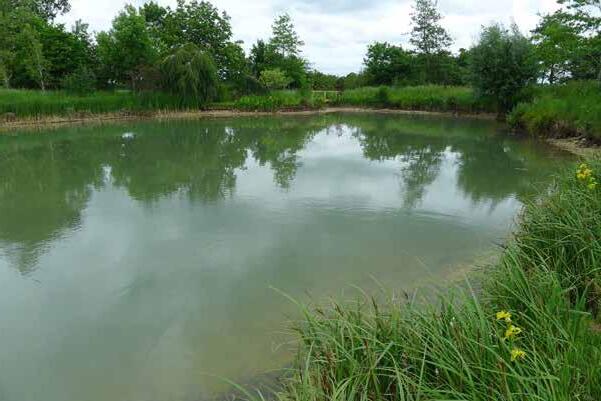
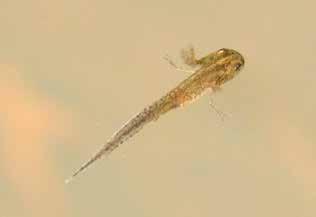
proportion of the invertebrates living in the lake (some of which would have been pumped to the ditch).
When the fish were netted, a selection was retained, and surplus were sold and taken away for restocking elsewhere.
40 common and mirror carp predominantly 4 kg + but all sizes were included with about 40 tench up to 25 cm long were kept. Hundreds of perch were removed and taken away as they had become invasive and as predators,
they were having a negative impact on the other pond life.
Soon after the transfer, the carp spawned and within a couple of weeks shoals of hundreds of tiny carp were seen.
After a few weeks of pumping water from our borehole, the water levels were high enough for the fish to swim to the opposite end. The fish activity made the water muddy which helped to reduce the growth of blanket weed which grew quickly in the hot sunny weather.
Up to June 20th, I was amazed to see more dragonflies and damsels than ever before, with large red, blue -tailed, common blue, and azure damsels, plus

banded demoiselles along with a record number of broad bodied chasers, emperor, four spotted chasers, black skimmers, and a possible sighting of a male hairy dragonfly. It remains to be seen if the later species show this year i.e. brown, southern, and migrant hawkers as well as ruddy and common darters. The willow emeralds may re the only other species I watch for is a rarity here: the common emerald. The newts spawned well with a night time count of 99 great crested newts and several smooth newts that appeared later.
Another species that survived the upheaval was the nationally scarce pond skater: Aquarius paladum (second Suffolk record – Adrian Chalkley) I know they have wings to help them avoid danger, but it was still a relief to see them again. With over 100 toads and a few frogs in the Spring it was unfortunate that the
untouched which helped retain some ‘residue’ and protect marginal plants which survived the hot dry weather long enough until the water reached them.
The whole job was carried out quickly and professionally by Tom Harbinson Countryside Services, a local pond specialist, using two 16 -ton excavators and two dumper trucks, two 75mm pumps and a team of hard-working people who knew what they were doing.
Image Captions:
Page 3: (Main image) Silt clearing; (Inset) Hairy Dragonfly - female laying eggs
Page 4: (Main image) North End Week 2; (Inset) Newt eft
Page 5: Skater Aquarius paladum

In the late 1990s, a few hundred metres to the east of Bury St Edmunds, a drainage basin was dug. Following subsequent development, it is now well within an industrial estate and takes surface water runoff from large areas of road, factory roof and car parks. You can see it from the A14 about 1.3km east of junction 44, once on the edge of town at TL881634. It has several hundred square metres of almost -permanent water, and around 1 hectare of dry sandy subsoil most of which has not yet been covered with water even in the most severe and prolonged storms.
After the basin was dug, its sandy, compacted, and infertile soils, probably subsoil, was sown with a wildflower mix of common species such as oxeye daisy Leucanthemum vulgare, black knapweed Centaurea nigra and lady’s bedstraw Galium verum. Grassland management was minimal, and the sward grew unmolested by mowers. Over the

years, the basin was used by off -road motorbike enthusiasts, and occasionally for dog walking and play. The disturbance, further compaction and bare soil began to allow something exciting to happen. The conditions were just right for one plant which grows well on this soil, and benefits from reduced competition from more vigorous species. A few plants of common cudweed Filago vulgaris began to appear, and by 2019 there were thousands and thousands of this little grey plant. On a national level it is declining rapidly and is classified as ‘Near Threatened ’, and in Suffolk it is found especially in Breckland and the Sandlings (Sanford and Fisk 2010).

In the 2020 spring lockdown, the drainage basin became very popular with people on foot and pedal cycles, and most of the sown ‘wildflowers’ and the cudweed were trampled out to leave almost bare soil. This year, 2021, the cudweed is making a good comeback with thousands of its seedlings reclaiming its former space. Even more excitingly, mossy stonecrop Crassula tillaea was also found this spring. It likes even more extreme dry sandy infertile soils, is rarer than cudweed and much rarer than the bee orchids and pyramidal orchids which receive public acclaim in the neighbouring housing estate. It is nationally scarce, but widespread on trampled tracks and other trampled areas in Breckland and the Sandlings and had not previously been recorded in grid square TL86 (Sanford and Fisk 2010). Mossy stonecrop is a tiny red plant, looking rather like a moss creeping over the ground. Its leaves are only a few millimetres long and its flowers are even smaller.
Normally, public recreation on wildlife sites causes immense harm, with loss and degradation to vegetation by trampling and pollution from dog faeces and urine. Trees can be damaged by the public, and unusual vertebrate species can be displaced by disturbance. In this drainage basin,
trampling has replaced an artificial but pretty ‘wildflower’ grassland with a natural grassland which contributes to the survival of uncommon species. The unplanned and informal use of the land has had the unintended
consequence of providing the conditions for rarer species to grow, improving its wildlife value. It ’s so unusual to have an example of where public recreation actually benefits wildlife.
Reference:
Richard West (1926 -2020), Professor of Botany at Cambridge University and Fellow of the Royal Society, joined the Suffolk Naturalists’ Society in 1953. As a research student of Clare College, Cambridge, he was awarded a SNS Morley Bursary in 1952 for investigating interglacial sites by the pollen analysis of their stratigraphy. One of the sites he studied was at Hoxne (see Transactions SNS volume 8, 1953) which had long attracted attention because of finds of palaeolithic flint hand -axes and is now the type-site for the Hoxnian interglacial. This was also the time that the ancient lake-bed at Bobbitshole, Ipswich, was discovered - soon to become the type-site of the Ipswichian interglacial. Richard also investigated
this and reported on two fossil water ferns to SNS Transactions. They were Azolla from Hoxne and Salvinia from Bobbitshole, both new to the British Pleistocene flora.
As a young research student he also questioned the remarkable Little OuseWaveney valley, its many fens and the origin of the Breckland sand. But his answers had to wait until he retired and walked the land. And it was to the SNS he presented his findings (Transactions SNS volume 47, 2007) ‘The Little Ouse River, the Waveney River and Breckland: a joint history ’, with further details in the acclaimed ‘From Brandon to Bungay ’, published by the SNS in 2009.

Back in April, Adrian Knowles, Hyme noptera county recorder, spotted an interesting sand pit area on the Ford Heath part of SWT Arger Fen & Spouse’s Vale nature reserve. He made several finds:
Andrena flavipes
Andrena minutula
Nomada zonata
Myrmica sabuleti
Lasioglossum calceatum
Lasioglossum minutissimum
Lasioglossum morio
Lasioglossum parvulum
Lasioglossum pauxillum
Sphecodes miniatus
Sphecodes monilicornis
Captions:
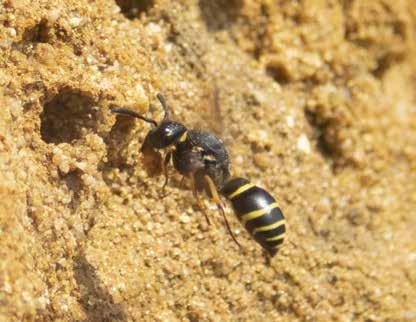
N. zonata is a relatively new species to the U.K. and is quite a find. However, Adrian said that the site is of interest and could well turn up other interesting species.
On the 29th May, I paid the site a visit to see what was there. I found the sand pit (TL 936 365), which was an excavated area approximately 30m long x 20m wide. The north end of the pit has a near vertical face about 4 -5m high with a metre thick band of compressed sand topped with a thin
layer of soil. Below the sand was a band of gravelly material. It was the top band that proved the most interesting, and I climbed up with some difficulty, through various brambles to see what was there. I found several hymenoptera flying around the sandy face and netted some specimens, which included two Chrysis wasps (Ruby-tailed wasps). I then noticed what looked to be the start of a construction around the entrance to one of the many nesting holes on the surface of the cliff. My thoughts immediately sprung to a species of wasp that builds a fine lattice chimney around the entrance of its nesting tunnel. Thanks to modern technology and a good phone signal, I was able to recall the species as Odynerus sp and as luck would have it, I managed to net a specimen, which was later confirmed to be O. spinipes. This is the first time that I have ever encountered this wasp and it was a joy to see.


Later that day, whilst running the specimens through various keys, the two Chrysis sp. Turned out to be Chrysis terminata, a newly determined species whose distribution is yet to be understood, and Pseudospinolia neglecta, a cleptoparasite of O.






spinipes. P. neglecta is a rare species of cuckoo wasp. My finding is only the third time it’s been recorded in Suffolk and the first record since 1998. The previous two sightings of this wasp were near Frostenden in 1926 and Elveden Forest in 1998.
On the 24th June I went back to see what activity there was and was amazed to see several lattice type chimneys protruding from the cliff face. Each chimney is about 3cm long by 1cm wide and they bend down from the entrance hole at the face. The very purpose of this chimney is not yet understood, one thought is that it stops cleptoparasites, such as P. neglecta, from entering the nest. I could see several Chrysididae (cleptoparasitic wasps) on the cliff face busily flying from one entrance hole to the next, but I did not observe any entering the ones with completed chimneys. There were also many O. spinipes flying in with their prey, which are larvae of Hypera sp (weevils), so providing a good pest removal service for the local environment.
So yes, the site was of much interest and may still turn up some surprising finds as the rest of the year unfolds. It’s amazing that little pockets of habitats like this can provide a home for so many species, including the rare ones. How many sites like this one are dotted across Suffolk, hidden in a small corner of a field somewhere? Many thanks to Adrian Knowles for his help and knowledge as well as finding this site.
Captions: (Bottom left) Entrance chimneys of O. spinipes & the entrances in various stages of construction (Middle) Area where wasps are nesting (Inset) Pseudospinolia neglecta
Following up from the 2020 survey of Picton Avenue and its adjoining land (Suffolk Natural History 2020 p.154 -5) we continued our walks there during the lockdown and on 5th February 2021 we took advantage of a warm sunny morning after rain and were hardly onto the footpath when my wife Marie, just in front, spotted two muntjac which went quickly into deeper cover. Their retreat lacked the usual tail raising when alarmed, suggesting they were used to disturbance. As we moved further along the footpath there was a sharp contrast between last year’s brown oak leaves framed against a blue sky and a bowl-shaped hazel full of sunlit male catkins, plus a few of the female flowers, with crimson styles emerging from their tips.
The mud left from recent rain revealed muntjac slots in abundance, so they obviously forage well away from cover in the quieter hours. A song thrush was a welcome addition then our first butterfly of the year, too far away to positively identify but its dark colour suggested it was a peacock. Plenty of gulls were searching the waterlogged field corners, probably for drowned worms and a buzzard’s familiar mewing call couldn’t be traced to an
actual sighting. An ivy -covered oak at the end of the field had two crows and a magpie which suggested a possible mobbing of the unseen buzzard but not on this occasion. By now we were listening to two great spotted woodpeckers, calling to keep in touch, one distant nearer Westerfield, the other closer somewhere in a nearby hedge. We decided to walk either side of this hedge to locate it and almost as soon as I went through a gap to the far side there was a hare moving away, the first one we had ever seen in this area. It came out of a ditch further along, almost certainly moving when another walker got too close. Seeing me it quickly changed direction, passing close to Marie on the other side of the hedge, so close she could see its bright staring eyes. It kept going right across the field until it reached the safety of a sheltering copse.
On our return two buzzards were calling and circling in what appeared to be a courtship flight and as we reached our front drive many bees were feeding on our winter honeysuckle. Hot chocolate with mini marshmallows was very welcome, as was the return of two coal tits to our bird feeders. For some frustrating
reason these had been absent during our one hour recording during the national Garden Birdwatch. As I wrote in the previous lockdown account (White Admiral 105, p.9-10) there was ‘nothing spectacular’ but this walk turned out to be a requiem for this
area, as we had previously known it. Just a few weeks later work was beginning on the extensive housing development with all but the existing footpaths being enclosed by long stretches of ugly metal fencing.
Well, almost nothing … an anther smut fungus in fact, but a special one. In June, Jo Jones and Rob Dyke of the Breckland Flora group were recording the population of Silene otites (Spanish Catchfly) at RAF Mildenhall when they came across a specimen seemingly infected by galls. Closer examination revealed the plant was infected by an anther smut which turned out to be Microbotryum major - a rare smut confined to Norfolk, Cambridgeshire, and one previous record from Tuddenham (Gallops?) Suffolk, found by the late Ted Ellis in 1963.
Smuts are not the easiest fungi to find, sometimes, as in the case of a rare plant such as Pinguicula vulgaris (Common Butterwort) growing in very damp conditions at Market Weston Fen, one has to get down on hands and knees to examine the
flowers by ever so carefully pulling back the stamens to see if the pure white pollen grains have been replaced by buff brown smut spores produced by Microbotryum pinguilae

This is no job for mycologists of retirement age and is a good example of why more ‘Fungi’ should be taught in schools (youngsters can climb up trees easier to collect fungal samples too!).
Returning to M. major recently found on Spanish Catchfly, there is a theory that this anther smut has in the past contributed to the extinction of the Vipers Bugloss Moth which feed on
Colin Hawes
In early June this year a turtle dove was heard calling in Bentley. However, it was several days before someone spotted this shy bird. Often perching on roof tops or in trees, its distinctive, loud, purring heard from a long way off. Around the middle of June this dove appeared in our front garden where it stayed for about thirty minutes feeding on a mix of chopped sunflower and peanut seed that had dropped from one of our bird feeders. It then began to appear regularly in the garden at around 13:30 hrs and stayed until 14:00 hrs, arriving again at 16:00 hrs and staying until about 16:30 hrs. A week or so later, much to our surprise, a second turtle dove arrived to join the first which had already started feeding. The behaviour of the pair, one with its throat ‘puffed up’ chasing the
the developing fruit - the fruits don’t develop when infected, so no caterpillar food.
My thanks to Alex Prendergast (Natural England) for informing me of this find and providing the photo of the voucher specimen and to Brian Douglas (Kew Mycology) for providing historical records.
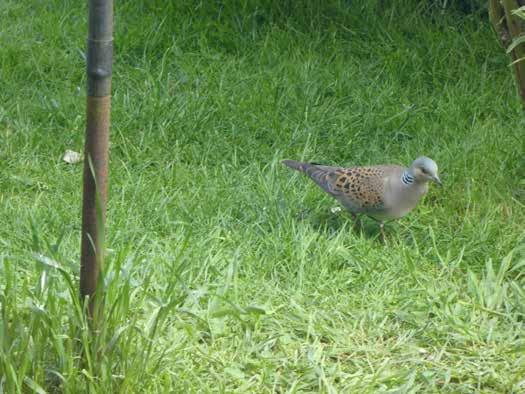
made to take a photograph of these birds through the glass of our front window but at the slightest movement from us the birds would fly off. One photograph of reasonable quality is included with this article. As I write, on the 28th of June, these turtle doves are still here in Bentley.
In recent issues of the White Admiral, and Suffolk Natural History I have tried to emphasise the role of parsonnaturalists in the development of natural history in Suffolk. It was often these men who did pioneer work on the insects, birds and plants of the county, were active in the formation of societies, and wrote early county floras and other works of reference. The reasons for the importance of the parson-naturalist genre are partly theological but are also social and legal.
Because of the legal doctrine of ‘parson’s freehold ’ a man could remain in his parish for as long as he wished: in the eighteenth and nineteenth centuries this was sometimes for life. Moreover, an association might extend for more than one generation. The patron, the person who held the advowson, or right to appoint the rector or vicar of a parish, might
Dear Patrick,
appoint a member of his family, and thus an individual might follow his father and grandfather into a parish. An individual might therefore get to know the plants, animals and people in his patch extremely well.
And just as parents often initiate their offspring into the delights of natural history, so there were families, where for many generations, all (or many of) the boys became clergy, and the girls (or many of them) married into parsonages. These two attributes occasionally coincided, and so it almost seems that the characteristics of the parson-naturalists are heritable!
SNS member Alfred Waller, after reading my short piece on Bishop Whittingham – the moth-collecting Bishop of St Edmundsbury and Ipswich - wrote to me a letter, here slightly edited, that perfectly illustrates these themes:
I was very interested to read the article on Bishop Whittingham in the recent issue of the White Admiral.
My grandfather, Canon A.P. Waller, was a great friend of the bishop and they went out ‘ mothing’ together all over Suffolk and Norfolk. My grandfather specialised in
the Pyralids and his collection of that group is now housed in the Natural History Museum in London. He and the bishop were collecting moths one night on the river Deben saltings in Hemley (one of grandfather ’s parishes) using a white sheet and an oil lamp. The village saw these highlighted figures acting peculiarly and ever since the saltings were regarded as being haunted by ghosts! My grandfather was also one of the original founders of The Suffolk Naturalists ’ Society with his friend Claude Morley. There was talk in my family that the bishop early promoted him to be a Canon of St Edmundsbury and Ipswich because of their mutual interest in entomology. I wouldn’t be at all surprised!
My naturalist grandfather encouraged me to take up entomology at an early age, and I have been a member of the Suffolk Naturalists ’ Society for around 70 years. I was also a keen bird -watcher. Back in the 1940s and 1950s I was a regular correspondent with the SNS entomology recorders, about captures of moths first in the telephone box in Waldringfield (the light of which attracted these insects) and then in my mercury vapour moth trap in the Rectory garden. Here is another entomological anecdote about my grandfather. One night he and I were ‘treacling’ i.e. daubing treacle mixed with rum on the Pine trees in the Rectory garden to attract moths. It was a good evening and a large number of moths were attracted to the tree trunks. We were ‘ boxing’ them as soon as possible but a number fell to the ground. As it happened there were some frogs and toads attracted by the fallen moths and were enjoying a tasty entomological snack. Other frogs appeared from elsewhere in the garden and within a quarter of an hour the amphibians were rolling on the ground totally intoxicated!
I did not receive ‘the call’ although my younger brother did, and was the fourth generation of Wallers to succeed to the Living of Waldringfield and Hemley. There was the Rev. Charles Waller in the Living in 1815 but en route to the USA his ship was wrecked and he perished so there was a gap until about 1838 when my great grandfather took over the living. As it happens I am still the Patron of the Living. My uncle was the Rector of Frostendon. He too was also an original member of the SNS.
Best wishes,
Alfred WallerI sincerely thank Alfred for permission to publish this correspondence, with its charming insights into both Suffolk
natural history, and the East Anglian tradition of the parson naturalist.
Once again, the AGM was a virtual meeting on ‘Zoom’ due to Covid 19 restrictions, held on 21st April 2021. Reports from the Chair, Treasurer and Secretary will be available on the SNS website and in Suffolk Natural History 2021 Vol. 57.
Bill Stone stepped down this year as the Suffolk County Recorder for Butterflies. He was thanked for many years of service and the incoming Recorder, James Corton, was warmly welcomed.
Matthew Deans started his first fouryear term as a Trustee and Juliet Hawkins was welcomed back for her second term. The Society is very grateful to all Trustees and Officers for their time and commitment to ensuring that SNS remains an important conservation charity in the county.
During the pandemic, Martin Sanford has not only been doing his own work as Chair, but has covered the role of Treasurer and that of Rosemary Milner, who, under normal circumstances, would deal with membership. The Society is extremely grateful to Martin for his outstanding work in ensuring that book sales continue to be met, the membership database is up to date, the accounts have been dealt with, and the day to day activities of SNS continue to run smoothly.
Kerry Calloway, Secretary of the Earthworm Society of Britain, gave an excellent live talk about the biology, ecology and recording of earthworms.
Kerry’s tremendous enthusiasm and extensive knowledge made for a fascinating presentation.
Kerry explained that ‘earthworm’ is
the common name for the largest members of the Oligochaeta in the phylum Annelida and went on to describe their life cycle. Earthworms are hermaphrodites with both worms containing male and female gametes, so they can self-fertilize or reproduce sexually. The saddle or clitellum

secretes a mucus which forms a cocoon for the eggs. The skin of the clitellum then sloughs off, capturing the fertilized eggs and creating an egg sac.
There are more than 5,000 species worldwide and about 31 species in the UK. At present, identification requires preserved specimens under a microscope as the diagnostic features are so small, but techniques are currently being investigated to make it possible to identify live specimens. However, it is relatively easy to identify the four ecotypes. Anecic earthworms are large and dark red dorsally, often darker towards the head; endogeic earthworms are often
pale, of medium to large size and rarely come to the surface; epigeic earthworms are small, red or dark in colour and feed on decaying plant material; and compost earthworms with distinctive dark red and often stripy colouration, feed on rotting material in compost bins.
Kerry highlighted the vital services provided by earthworms. They are one of nature’s ‘ Ecosystem Engineers ’ because they are capable of modifying their habitat and facilitating the availability of resources to other species. Earthworms recycle soil with their ‘casts’, drain and aerate the soil with their burrows and are known as ‘Nature’s Plough’ because they create disturbance of soils and sediments. Even huge stones can gradually sink below the surface through the long
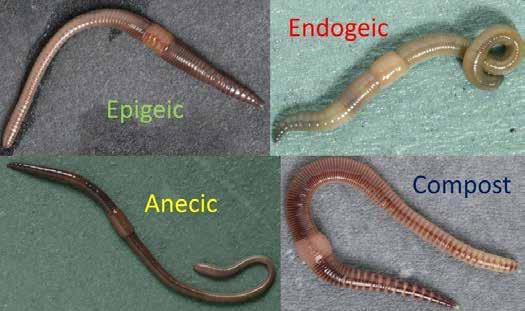
term work of earthworms. They are also an important food source for other animals such as birds, hedgehogs, frogs, badgers and moles.
If you feel inspired to learn more, visit the Earthworm Society of Britain website at:
www.earthwormsoc.org.uk and do take a look at Kerry ’s great presentation on the SNS website at http:// www.sns.org.uk/files/pdfs/ Earthworms%20Kerry% 20Calloway.pdf

Captions: (Bottom left) The four earthworm ecotypes (Top right) Earthworm burrows drain and aerate the soil (Earthworm Society of Britain)
Dennis & Anne Kell
As we write this, we have just completed our National Bat Monitoring Programme (NBMP) Roost Survey for 2021 and are preparing for the Field Survey in July. Like the Roost Survey, the Field Survey is co-ordinated by the Bat Conservation Trust (BCT) and is a national survey to collect data around the UK, helping to build a more accurate data base on current population trends to inform future conservation strategies.
Unlike the Roost Survey which can be undertaken from the comfort of a chair in your own garden and requires no special equipment, the Field Survey
takes place in the local area following a set route and uses a tuneable bat detector to identify and count specific species. The Suffolk Bat Group (SBG) can loan bat detectors to those who would like to take part (see later).
Simple training is required before starting this survey. SBG have organised training courses on behalf of BCT around the County prior to the current difficulties. Alternatively, online training can be found on the BCT website (see later). Although it sounds complicated at first, the careful, wellstructured course quickly builds confidence.
The training explains the survey and its protocols and shows how to plan a route which follows a roughly triangular walk inside a one kilometre square. On each side of the triangle four points are identified. At each of these twelve points, we listen for two minutes with the bat detector tuned to recognise Pipistrelle bats. The twelve walks between each of the points are also part of the survey, but here the bat detector is tuned to recognise Serotine and Noctule bats. We record the total number of passes heard at each point or walk. So, unlike the roost count, this is not a count of individual bats, but passes made at that point or walk.
An important part of the training course is devoted to using the bat detectors and distinguishing the different calls of Soprano and Common Pipistrelles, Noctule and Serotines both in the classroom and out in the field. We both found our training course at Lackford Lakes very empowering under the patient tuition of Bill Landells from the SBG. The two Pipistrelle species echolocate on around 45 or 55 kHz (kilohertz). Noctules call at around 22 kHz and Serotines at around 28 kHz. So the bat detectors are set at 50 for the points and 25 for the walks. With a little careful tuning once a bat is heard, it is usually possible to distinguish between the two after completing the
training. However, there is also space to record uncertain records where bats were heard but could not be distinguished.
With some models of bat detector, calls can be recorded and analysed later in the comfort of your own home. We tend to rely on our ears, a pencil and notebook – but don’t forget the torch.
Having completed the training, it is simple to register with BCT and be given a survey square, usually close to home. It is important to plan a route in daylight before attempting the survey at night and, if necessary, to obtain any permissions to cross private land. We are fortunate to remain on footpaths or roads throughout the survey.
Our route takes us through the village, past a variety of different housing, a Victorian school, a church and a Tudor barn as well as open fields, small copses and along a variety of roads. As can be seen from the results, we have recorded Pipistrelle bats at all twelve points over the years. Noctules have been recorded in most years but only one Serotine has been recorded so far.
Two surveys are carried out in July each year, one in the first two weeks and one in the second. Each begins twenty minutes after sunset with walk number 1 and finishes with a count at point number 12. We set up the

notebook ready and carry torches, bat detectors, high vis jackets, a charged mobile and counters. It is usually still light at the start and a few swifts may still scream past but is quite dark by the end and meeting a badger on the quiet road was a shock to all parties concerned. Cloud cover, wind, temperature and precipitation are also recorded along with start and finish times.
The field work is the most enjoyable part of the survey. Being out when
most people are inside makes everything more personal. It is frustrating to see a pipistrelle when we are on a walk, especially if there are none at the next point, but that ’s field work. With two people, one can concentrate on counting passes whilst the other can confirm the species if necessary. Earphones can help to focus on the sounds from your own bat detector!
Caption: NBMP Field Survey – Route Plan showing Points and Walks.
Over the last nine years, we have recorded 622 passes by Common Pipistrelles, 22 by Soprano Pipistrelles and 13 uncertain Pipistrelle passes. On the walks we have recorded 56 Noctule passes, 1 Serotine and 3 uncertain Noctule/Serotines. When looking at the data for East Anglia for last year, we were surprised to observe that our count of 62 passes by Common Pipistrelles was the highest in the
region. So, a good use of our daily exercise in 2020. Overall, Field Survey site records fell by 17% last year, no doubt due to pandemic restrictions.


Nationally, the NBMP has been running for over 20 years and the current trends released by BCT in May 2021 indicate that 5 of Britain’s 17 bat species are showing positive signs of population increase whilst a further 6 appear to be stable.
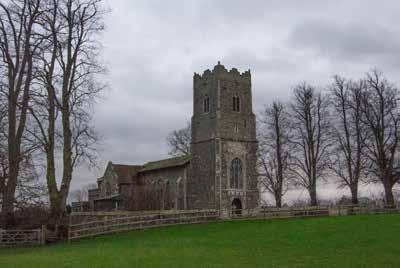
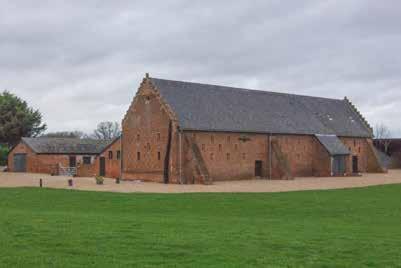
Both Common and Soprano Pipistrelles are amongst those making an increase whilst both Noctules and Serotines appear to be stable.
However, Philip Briggs, Monitoring Manager at the BCT, said: “No species for which we produce population trends are considered to have declined significantly since we began monitoring. While the data indicate that bat species we monitor are stable or recovering, it should be remembered that these trends reflect relatively recent changes in bat populations.
“Historically, there were significant declines in bat populations throughout the 20th century. The new trends suggest current legislation and conservation actions to protect them
are proving successful, and it is vitally important this continues.” (1).
Do consider taking part in the NBMP. Whether it is for the Field Survey in July, Waterways Survey in August or Roost Survey in June, full details can be found on the BCT website.
Suffolk Bat Group also organise local surveys, can provide equipment and welcome volunteers. So if you are interested in taking part or wish to find out more have a look at the
Suffolk Bat Group:
https://www.suffolkwildlifetrust.org/ suffolkbatgroup
Bat Conservation Trust NBMP:
https://www.bats.org.uk/our-work/ national-bat-monitoring-programme
Reference:
(1) “Positive Signs for Britain’s Bat Species”
https://www.bats.org.uk/news/2021/05/positive-signs-for-britains-bat-species
Captions:
Breckland is one of the driest places in the country, with an average of around 600mm of rainfall per year. Soils are free-draining, and plants are adapted to drought conditions. For example, whilst most plants open their
Nick Sibbett
stomata (‘leaf-holes’) to allow fresh air into the leaf during the day and to let waste oxygen out, one heathland plant does the opposite. To prevent daytime loss of water evaporating from its stomata, mossy stonecrop
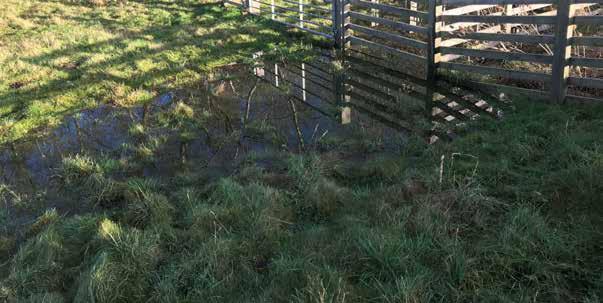
Crassula tillea closes its stomata during the day and opens them at night. This severely limits its photosynthesis, so it grows very slowly, but allows it to cope with the drought. So how did blanketweed, Cladophora or a similar species, grow in abundance on a heath?
On Boxing Day 2020, a heavy rainstorm resulted in surface water flooding on part of West Stow Heath SSSI, close to the River Lark. This SSSI contains wet woodland on the floodplain, and dry heath is contiguous to the wet woodland. Puddles formed on the heathland close to the wet woodland (TL78837132). Later in January 2021, a further heavy rainstorm resulted in more surface water over part of the heath, the first time this has been seen in decades. It is thought that this was groundwater rather than simply a puddle, because
the adjacent wet woodland, which is often wet in winter, was also flooded (and remains so at the time of writing in June 2021).
The flood water was prevented from soaking away as groundwater levels slowly dropped, by a layer of clay in the soil around 300mm - 500mm below the soil surface. The flood water persisted, as it evaporated from the exposed groundwater, other water from under higher land in the heath took its place. In effect, only part of the groundwater was exposed to the atmosphere, so evaporation took much longer than if the water open to the sky was the only water to be lost by evaporation. Blanket weed appeared in the flood water, and grew rapidly. By April, the flood water was covered with this green alga. Only throughout the April 2021 drought, with only 1.8mm of rainfall instead of
the average 54mm (en.climatedata.org) did the water level drop. The heath was left with a layer of blanketweed over the dry-again heath, which smothered the vegetation beneath. The blanketweed dried out by the end of April 2021 and became a white blanket, only broken by trampling.
The heathland habitat will surely recover from flooding and smothering by blanketweed. It was left in place instead of being removed, as a natural phenomenon. No doubt some invertebrates, fungi and bacteria species will benefit from the event, whist others may undergo population loss. There is no biological monitoring of this event, but it will remain as one of nature ’s surprises - the year that blanketweed grew on the heath!

One of my most exciting moments in wintertime was when I first saw Mandarins (Aix galericulata) at Flatford on 27th October, the quite exquisite, colourful, stylish, and endearing
ducks. Quite a distance (c. 50m) away from the Longhurst Hide at Flatford, the three males were perched, side by side, on a large fallen log under a canopy of large willows on the left

bank of Gibbonsgate Lake (the result of gravel excavation in the mid-eighties). Their identification came into focus only when I trained my binoculars on these beautiful medium-sized ducks. I was simply ecstatic as the colour materialised and the long coppery -orange whiskers and the light orange tertiary ‘sails’ with a white border came into view. Other details were manifest as I continued to observe them, a pinkish -red beak with a white tip, a greeny -blue head stripe sweeping backwards into a dark orange crest, a white eye ring around dark eyes merging into a yellowywhite stripe running back from the eye. A purplish breast came into view as they occasionally turned round, showing off the two contrasting white bars on either side of the breast. No doubt the micro-detail would be even more particular.


One of them suddenly jumped the three-foot into the water and started
to move around frolicking like a spring lamb and making rough and repeating, slightly low-pitched vibrating sounds, as if clearing its throat! Was it calling down the others? And sure enough the second one jumped down and then the third one, joining him to ‘ dance’ on the water. The way they moved reminded me of ‘whirligig beetles ’. After nearly ten minutes of this, one of them started to move further up the lake and in no time, they were little specks. A wonderful experience. However, on repeated visits, I didn ’t see them there again for quite a while. The next time I saw them was on 18th January, again quite inadvertently. For those who know Flatford, the grazing meadows on either side of the Stour


often get flooded in the winter and this year the flooding (see Picture 1) was quite relentless and lasted on and off for weeks. Water water everywhere, nowhere to proceed. So, you had to embark on wading through flowing floodwaters. Past the bridge after Bridge Cottage, the river had broken the bank, the water freely flowing into what at most times was a dry ditch on the right, but which was exceptionally full now, water surging fast and parallel to the main river. The raised path beyond the Flatford lock was not so wet but flood waters abounded on either side. It was from about 100 metres down this muddy track that I saw some dark shapes disappearing under some low deciduous tree branches in the flood waters on my right. But as I looked, I heard those characteristic sounds again and I knew they were ‘my’ mandarins. I stopped to investigate and through the vegetation I got a glimpse. Here they were, not entirely visible, and secretively climbing onto a
again one of them jumped down and the others followed but they carefully remained hidden and in the shade. Occasionally, they would break cover and come out in the open, generally not long enough for me to take a halfdecent photo. But I waited and persevered and was rewarded (see picture 2). I saw them on a number of occasions after this and in the same locality. However, when the floods receded in February and the water levels fell, they were not to be seen here again.
But to my delight, they were back in their old ‘Gibbonsgate Lake’ TM079329 haunt on 2nd March. Same perch and same exploits. But they were not there for long. After some play, they paddled away north (see picture 3) and were soon out of sight. This was also to be my last sighting of them for the ‘time -being’. Au revoir, I murmured. I was glad of all my encounters with them. And also pleased that Britain had become a home for these introduced species

“You have got a lot of lodgers! ” said the friendly decorator as we showed him round for a painting job on the outside of the house. We were discussing how we could work round the swift boxes. These are currently occupied by house sparrows. We were delighted when the sparrows took up residence as we had been trying to entice them from the bungalows over the road for years and blue tits had taken over the ‘sparrow terrace’ box bought at vast expense. We had just been in the garage to discuss paint; the wood pigeon who had built her nest on the very ends of the timber planks stored in the rafters took no notice. She would stare at us balefully when we got in the car and even tolerated us looking at her from the top of a ladder only flying off if we got too close. She has two precious eggs. Funnily enough she is the pigeon I caught in the vegetable garden tunnel where we grow Brassica – specifically to protect them from pigeons. I cornered her, grabbing her tail; she shed all the feathers and escaped with a ridiculous stump and ungainly flight. Nesting in the garage and dropping
poo and twigs on the car was her revenge. The garage also quite rightly has swallows nesting. Sadly, 4 nestling bodies were found, perhaps as a result of the recent cold rainy weather. The adults are still about so may try again. There are no bats in the carefully built bat box – they prefer it behind the weatherboarding and the tree bees


have not taken up residence in the camera nest box this year. I haven’t seen the stock doves that normally occupy one barn owl nest box but the other box has jackdaws as tenants. The barn owl patrols the nearby fields but must be nesting elsewhere. All the bird boxes put up this year

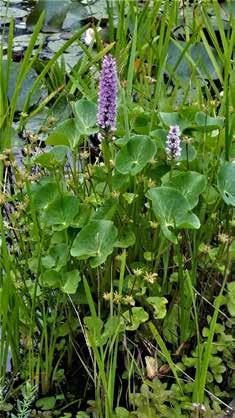

have been occupied by the correct species – according to hole size. These woodcrete boxes are very popular and certainly cause much arguing before one pair establishes ownership; a pair of blue tits once examined a box placed on the garden bench even before
It doesn’t stop with birds. Some time ago, I rescued some southern marsh and common spotted orchids from a building site and moved them to the garden. They have now spread in the flower bed and the latter amongst the marsh marigold in the pond and there are now two plants with feet firmly in the water. There were a dozen or so bee orchids in the lawn last year meaning that we couldn ’t mow for
Events in September
weeks but this year they (or just one) has decamped to the flower bed.
Large black ants took up residence in the house wall and had to be evicted as they were emptying out the insulation.
There are also common newts in the pond and a host of damselfly, dragonfly, and darter - so some things do know their place!
For a unique experience this summer join Kate Osborne from Beach Bonkers on a treasure hunt of Suffolk ’s internationally rare shingle beaches. Using sustainable beachcombing, we will explore this fragile habitat and
discover the stories of the objects cast up onto the shore. From sea snails that lay cannibal eggs to driftwood riddled with shipworm to fifty million year old fossil sharks’ teeth there are many tales of treasure to discover.




Events in September:
• Beachcombing for all on Bawdsey Beach - Saturday, September 18th, 20212:30 pm 4:30 pm - Bawdsey beach, Ferry road, Ip12 3ax
Booking is essential as places are limited. This beachcomb has a limited number of subsidised places available at £1 a head thanks to a grant from Suffolk Coast & Heaths Sustainable Development Fund. See event listing for full details.
• Beachcombing for all on Felixstowe Beach. – Sunday, September 26th 2021 –10:00 am – 11:30 am - Visit Felixstowe beach hut opposite Felixstowe Town Hall, Undercliff Road, Felixstowe, Ip11 2ag
Booking is essential as places are limited. See event listing for full details.
For more details and to book visit:
https://www.beachbonkers.org.uk/come -to-the-beach
Bespoke beachcombing is also available.
For full details see www.beachbonkers.org.uk or call Kate on 0751 255 7200.
Captions: (Opposite left) Sharks teeth handful post lockdown (Opposite right) Slipper limpet stack
Ben Heather
Over the next year and a half I will be continuing to deliver the Discovering Suffolk project for the Green Access team at Suffolk County Council. I am currently in the process of developing a walking mobile app for Suffolk which will enable the general public to access high quality digital mapping as well as a selection of tried and tested walking

guides on their mobile devices whilst out and about. The next key objective of the project will be the creation of digital fingerposts throughout Suffolk by attaching new quick response (QR) code plaques to existing roadside footpath posts. The plaques will initially feature codes that link to both the Discover Suffolk website and the
Countryside Code enabling a new generation of footpath users to quickly access information to both improve their experience and understanding of the countryside.
I am currently looking for volunteers across the county to help install these small plaques onto existing posts. I have, so far, had a very positive response from many parish councils offering to help but there will
inevitably be some gaps that will need filling with additional volunteer effort.
If you are a keen walker and would be happy to volunteer to install some plaques in your local patch (the only tool required is a hammer) please do get in touch with me at ben.heather@suffolk.gov.uk and I will get back to you with more information.
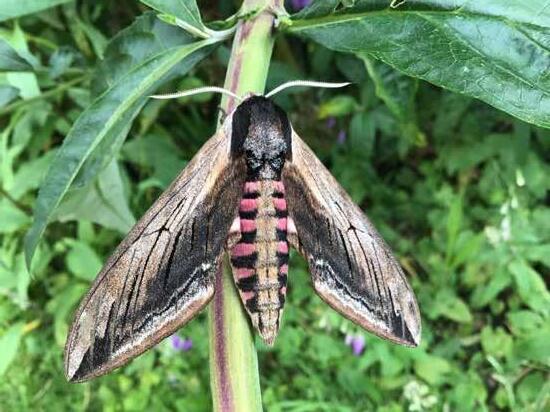
The Suffolk Naturalists’ Society offers six bursaries, of up to £500 each, annually. Larger projects may be eligible for grants of over £500 – please contact SNS for further information.
Activities eligible for funding include: travel and subsistence for field work, visits to scientific institutions, scientific equipment, identification guide books or other items relevant to the study.
Morley Bursary - Studies involving insects (or other invertebrates) other than butterflies and moths.
Chipperfield Bursary - Studies involving butterflies or moths.
Cranbrook Bursary - Studies involving mammals or birds.
Rivis Bursary - Studies of the county's flora.
Simpson Bursary - In memory of Francis Simpson. The bursary will be awarded for a botanical study where possible.
Nash Bursary - Studies involving beetles.
Applications should be set in the context of a research question i.e. a clear statement of what the problem is and how the applicant plans to tackle it.
Criteria:
1. Projects should include a large element of original work and further knowledge of Suffolk’s flora, fauna or geology.
2. A written account of the project is required within 12 months of receipt of a bursary. This should be in a form suitable for publication in one of the Society's journals: Suffolk Natural History, Suffolk Birds or White Admiral.
3. Suffolk Naturalists' Society should be acknowledged in all publicity associated with the project and in any publications emanating from the project.
Applications may be made at any time. Please apply to SNS for an application form or visit our website for more details www.sns.org.uk/pages/bursary.shtml.

The Suffolk Naturalists’ Society, founded in 1929 by Claude Morley (1874 -1951), pioneered the study and recording of the County’s flora, fauna and geology. It is the seed bed from which have grown other important wildlife organisations in Suffolk, such as Suffolk Wildlife Trust (SWT) and Suffolk Bird Group (SBG).
Recording the natural history of Suffolk is still the Society ’s primary objective. Members’ observations go to specialist recorders and then on to the Suffolk Biological Records Centre at Ipswich Museum to provide a basis for detailed distribution maps and subsequent analysis with benefits to environmental protection.
Funds held by the Society allow it to offer substantial grants for wildlife studies.
Annually, SNS publishes its transactions Suffolk Natural History, containing studies on the County’s wildlife, plus the County bird report, Suffolk Birds (compiled by SBG). The newsletter White Admiral, with comment and observations, appears three times a year. SNS organises two members’ evenings a year and a conference every two years.
Subscriptions to SNS: Individual membership £15; Family/Household membership £17; Student membership £10; Corporate membership £17. Members receive the three publications above.
Joint subscriptions to SNS and SBG: Individual membership £30; Family/Household membership £35; Student membership £18. Joint members receive, in addition to the above, the SBG newsletter The Harrier.
As defined by the Constitution of this Society its objectives shall be:
2.1 To study and record the fauna, flora and geology of the County
2.2 To publish a Transactions and Proceedings and a Bird Report. These shall be free to members except those whose annual subscriptions are in arrears.
2.3 To liaise with other natural history societies and conservation bodies in the County
2.4 To promote interest in natural history and the activities of the Society.
For more details about the Suffolk Naturalists’ Society contact:
Hon. Secretary, Suffolk Naturalists’ Society, c/o Ipswich Museum, High Street, Ipswich, IP1 3QH. Telephone 01473 400251
enquiry@sns.org.uk